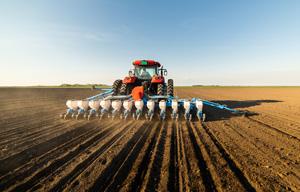 Electromagnetic flowmeters, also known as magnetic flowmeters or magmeters, use Faraday’s Law of Electromagnetic Induction to determine the flow of liquid in a pipe. In an electromagnetic flowmeter, a magnetic field is generated and channeled into the liquid flowing through the pipe. Following Faraday’s Law, flow of a conductive liquid through the magnetic field will cause a voltage signal to be sensed by electrodes located on the flow tube walls. When the fluid moves faster, more voltage is generated. Faraday’s Law states that the voltage generated is proportional to the movement of the flowing liquid. The electronic transmitter processes the voltage signal to determine liquid flow.
Electromagnetic flowmeters, also known as magnetic flowmeters or magmeters, use Faraday’s Law of Electromagnetic Induction to determine the flow of liquid in a pipe. In an electromagnetic flowmeter, a magnetic field is generated and channeled into the liquid flowing through the pipe. Following Faraday’s Law, flow of a conductive liquid through the magnetic field will cause a voltage signal to be sensed by electrodes located on the flow tube walls. When the fluid moves faster, more voltage is generated. Faraday’s Law states that the voltage generated is proportional to the movement of the flowing liquid. The electronic transmitter processes the voltage signal to determine liquid flow.
In contrast with many other flowmeter technologies, electromagnetic flowmeter technology produces signals that are linear with flow. As such, the turndown associated with magnetic flowmeters can approach 20:1 or better without sacrificing accuracy. Continue reading “How Electromagnetic Flowmeters Work”
 In the dynamic landscape of industrial instrumentation, every application has its unique demands. We want to ensure that our products meet your application needs. To do that, Dwyer Instruments provides not only a user-friendly online product configurator, but also a Fast Track Program for a fully customized solution.
In the dynamic landscape of industrial instrumentation, every application has its unique demands. We want to ensure that our products meet your application needs. To do that, Dwyer Instruments provides not only a user-friendly online product configurator, but also a Fast Track Program for a fully customized solution.




 There’s a saying: “An ounce of prevention is worth a pound of cure,” and this is no different with your sensors and controls of the greenhouse/indoor farming equipment that you use and rely upon everyday. Similar to any controlled environment, it is vital to monitor and proactively interpret the pressure, temperature, relative humidity, carbon dioxide (CO2) supplementation, and irrigation of your growing space. Losing control of your environment can lead to cultivation headaches ranging from poor air flow to extreme temperatures; additionally, high humidity and low irrigation rates can lead to the spread of disease and viruses.
There’s a saying: “An ounce of prevention is worth a pound of cure,” and this is no different with your sensors and controls of the greenhouse/indoor farming equipment that you use and rely upon everyday. Similar to any controlled environment, it is vital to monitor and proactively interpret the pressure, temperature, relative humidity, carbon dioxide (CO2) supplementation, and irrigation of your growing space. Losing control of your environment can lead to cultivation headaches ranging from poor air flow to extreme temperatures; additionally, high humidity and low irrigation rates can lead to the spread of disease and viruses. 
 The summer is always a busy time for our team, as we check and double check the formatting and information of our annual instrumentation catalog. Now that autumn is here, we’re proud to announce that the new Dwyer Catalog is now available!
The summer is always a busy time for our team, as we check and double check the formatting and information of our annual instrumentation catalog. Now that autumn is here, we’re proud to announce that the new Dwyer Catalog is now available!